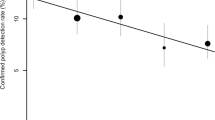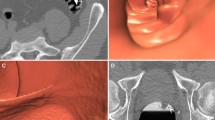Abstract
Objectives
To assess the effectiveness of computer-aided detection (CAD) as a second reader or concurrent reader in helping radiologists who are moderately experienced in computed tomographic colonography (CTC) to detect colorectal polyps.
Methods
Seventy CTC datasets (34 patients: 66 polyps ≥6 mm; 36 patients: no abnormalities) were retrospectively reviewed by seven radiologists with moderate CTC experience. After primary unassisted evaluation, a CAD second read and, after a time interval of ≥4 weeks, a CAD concurrent read were performed. Areas under the receiver operating characteristic (ROC) curve (AUC), along with per-segment, per-polyp and per-patient sensitivities, and also reading times, were calculated for each reader with and without CAD.
Results
Of seven readers, 86 % and 71 % achieved a higher accuracy (segment-level AUC) when using CAD as second and concurrent reader respectively. Average segment-level AUCs with second and concurrent CAD (0.853 and 0.864) were significantly greater (p < 0.0001) than average AUC in the unaided evaluation (0.781). Per-segment, per-polyp, and per-patient sensitivities for polyps ≥6 mm were significantly higher in both CAD reading paradigms compared with unaided evaluation. Second-read CAD reduced readers’ average segment and patient specificity by 0.007 and 0.036 (p = 0.005 and 0.011), respectively.
Conclusions
CAD significantly improves the sensitivities of radiologists moderately experienced in CTC for polyp detection, both as second reader and concurrent reader.
Key Points
• CAD helps radiologists with moderate CTC experience to detect polyps ≥6 mm.
• Second and concurrent read CAD increase the radiologist’s sensitivity for detecting polyps ≥6 mm.
• Second read CAD slightly decreases specificity compared with an unassisted read.
• Concurrent read CAD is significantly more time-efficient than second read CAD.





Similar content being viewed by others
References
Pickhardt PJ, Choi JR, Hwang I et al (2003) Computed tomographic virtual colonoscopy to screen for colorectal neoplasia in asymptomatic adults. N Engl J Med 349:2191–2200
Johnson CD, Chen MH, Toledano AY et al (2008) Accuracy of CT colonography for detection of large adenomas and cancers. N Engl J Med 359:1207–1217
Graser A, Stieber P, Nagel D et al (2009) Comparison of CT colonography, colonoscopy, sigmoidoscopy and faecal occult blood tests for the detection of advanced adenoma in an average risk population. Gut 58:241–248
Regge D, Laudi C, Galatola G et al (2009) Diagnostic accuracy of computed tomographic colonography for the detection of advanced neoplasia in individuals at increased risk of colorectal cancer. JAMA 301:2453–2461
Atkin W, Dadswell E, Wooldrage K et al (2013) Computed tomographic colonography versus colonoscopy for investigation of patients with symptoms suggestive of colorectal cancer (SIGGAR): a multicentre randomised trial. Lancet 381:1194–1202
Doshi T, Rusinak D, Halvorsen RA et al (2007) CT colonography: false-negative interpretations. Radiology 244:165–173
Fletcher JG, Chen MH, Herman BA et al (2010) Can radiologist training and testing ensure high performance in CT colonography? Lessons From the National CT Colonography Trial. AJR Am J Roentgenol 195:117–125
Liedenbaum MH, Bipat S, Bossuyt PM et al (2011) Evaluation of a standardized CT colonography training program for novice readers. Radiology 258:477–487
Dachman AH, Kelly KB, Zintsmaster MP et al (2008) Formative evaluation of standardized training for CT colonographic image interpretation by novice readers. Radiology 249:167–177
Boone D, Halligan S, Frost R et al (2011) CT colonography: who attends training? A survey of participants at educational workshops. Clin Radiol 66:510–516
Regge D, Halligan S (2013) CAD: how it works, how to use it, performance. Eur J Radiol 82:1171–1176
Mang T, Peloschek P, Plank C et al (2007) Effect of computer-aided detection as a second reader in multidetector-row CT colonography. Eur Radiol 17:2598–2607
Dachman AH, Obuchowski NA, Hoffmeister JW et al (2010) Effect of computer-aided detection for CT colonography in a multireader, multicase trial. Radiology 256:827–835
Halligan S, Mallett S, Altman DG et al (2011) Incremental benefit of computer-aided detection when used as a second and concurrent reader of CT colonographic data: multiobserver study. Radiology 258:469–476
Graser A, Kolligs FT, Mang T et al (2007) Computer-aided detection in CT colonography: initial clinical experience using a prototype system. Eur Radiol 17:2608–2615
Plumb AA, Halligan S, Taylor SA et al (2013) CT colonography in the English Bowel Cancer Screening Programme: national survey of current practice. Clin Radiol 68:479–487
Halligan S, Altman DG, Mallett S et al (2006) Computed tomographic colonography: assessment of radiologist performance with and without computer-aided detection. Gastroenterology 131:1690–1699
Taylor SA, Charman SC, Lefere P et al (2008) CT colonography: investigation of the optimum reader paradigm by using computer-aided detection software. Radiology 246:463–471
Petrick N, Haider M, Summers RM et al (2008) CT colonography with computer-aided detection as a second reader: observer performance study. Radiology 246:148–156
Baker ME, Bogoni L, Obuchowski NA et al (2007) Computer-aided detection of colorectal polyps: can it improve sensitivity of less-experienced readers? Preliminary findings. Radiology 245:140–149
Regge D, Della Monica P, Galatola G et al (2013) Efficacy of computer-aided detection as a second reader for 6-9-mm lesions at CT colonography: multicenter prospective trial. Radiology 266:168–176
Virtual Colonoscopy Training Collection from the Virtual Colonoscopy Center, Walter Reed Army Medical Center and Naval Medical Center San Diego. In: https://wiki.nci.nih.gov/display/CIP/Virtual_Colonoscopy
Neri E, Halligan S, Hellstrom M et al (2013) The second ESGAR consensus statement on CT colonography. Eur Radiol 23:720–729
Burling D (2010) CT colonography standards. Clin Radiol 65:474–480
American College of Radiology (2009) ACR practice guideline for the performance of computed tomography (CT) colonography in adults. ACR, Reston
Zalis ME, Barish MA, Choi JR et al (2005) CT colonography reporting and data system: a consensus proposal. Radiology 236:3–9
Bogoni L, Cathier P, Dundar M et al (2005) Computer-aided detection (CAD) for CT colonography: a tool to address a growing need. Br J Radiol 78(Spec No 1):S57–S62
Obuchowski NA (2007) New methodological tools for multiple-reader ROC studies. Radiology 243:10–12
Hillis SL (2007) A comparison of denominator degrees of freedom methods for multiple observer ROC analysis. Stat Med 26:596–619
Obuchowski NA (1998) On the comparison of correlated proportions for clustered data. Stat Med 17:1495–1507
Mang T, Bogoni L, Salganicoff M et al (2012) Computer-aided detection of colorectal polyps in CT colonography with and without fecal tagging: a stand-alone evaluation. Invest Radiol 47:99–108
Lawrence EM, Pickhardt PJ, Kim DH et al (2010) Colorectal polyps: stand-alone performance of computer-aided detection in a large asymptomatic screening population. Radiology 256:791–798
Mang T, Gryspeerdt S, Schima W et al (2013) Evaluation of colonic lesions and pitfalls in CT colonography: a systematic approach based on morphology, attenuation and mobility. Eur J Radiol 82:1177–1186
De Vries AH, Jensch S, Liedenbaum MH et al (2009) Does a computer-aided detection algorithm in a second read paradigm enhance the performance of experienced computed tomography colonography readers in a population of increased risk? Eur Radiol 19:941–950
Neri E, Faggioni L, Regge D et al (2011) CT colonography: role of a second reader CAD paradigm in the initial training of radiologists. Eur J Radiol 80:303–309
Mang T, Hermosillo G, Wolf M et al (2012) Time-efficient CT colonography interpretation using an advanced image-gallery-based, computer-aided "first-reader" workflow for the detection of colorectal adenomas. Eur Radiol 22:2768–2779
Iussich G, Correale L, Senore C et al (2013) CT colonography: preliminary assessment of a double-read paradigm that uses computer-aided detection as the first reader. Radiology 268:743–751
Ryan JT, Haygood TM, Yamal JM et al (2011) The "memory effect" for repeated radiologic observations. AJR Am J Roentgenol 197:W985–W991
Acknowledgements
The scientific guarantor of this publication is Thomas Mang MD (Department of Biomedical Imaging and Image-guided Therapy, Medical University of Vienna, Austria).
The authors of this manuscript declare that six study contributors (L.B., V.A., G.H., V.R., M.S., M.W.) are employees of Siemens Medical Solutions USA. The study coordinator (non-author), as well as all seven readers (D.C., A.J.C, A.S.L.T, R.N., R.S., S.S., R.F.R.T) received financial research support, as well as reimbursement of travel expenses, from Siemens Medical Solutions USA, Inc.
The remaining authors of this manuscript declare no relationships with any companies whose products or services may be related to the subject matter of the article.
Siemens Medical Solutions USA (Malvern, PA) provided equipment (hardware and software) and technical assistance during the study.
Nancy A. Obuchowski, PhD (Department of Quantitative Health Sciences, Cleveland Clinic, Cleveland, Ohio, USA) and Michael Weber, PhD (Department of Biomedical Imaging and Image-guided Therapy, Medical University of Vienna, Austria) kindly provided statistical advice for this manuscript. A contract with a large statistical group was established to have an independent statistician (N.O.) perform the analysis.
Institutional Review Board approval was obtained. Written informed consent was waived by the Institutional Review Board. Some study subjects or cohorts have been previously reported by Pickhardt et al. [1]; Mang et al. [31] and Mang et al. [36]
Methodology: retrospective (from multiple sites), multi-reader multi-case study, diagnostic study, performed at one institution.
Author information
Authors and Affiliations
Corresponding author
Rights and permissions
About this article
Cite this article
Mang, T., Bogoni, L., Anand, V.X. et al. CT colonography: effect of computer-aided detection of colonic polyps as a second and concurrent reader for general radiologists with moderate experience in CT colonography. Eur Radiol 24, 1466–1476 (2014). https://doi.org/10.1007/s00330-014-3158-1
Received:
Revised:
Accepted:
Published:
Issue Date:
DOI: https://doi.org/10.1007/s00330-014-3158-1




